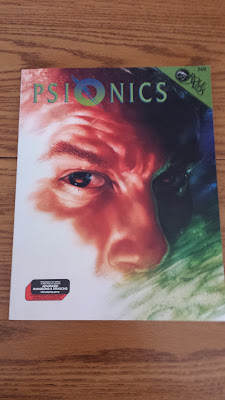The Intermediate adventures for experienced adventures but not quite what we call "name" level (9th and above). This is also what many call the prime adventuring levels. Also many of these were ranked in the 30 greatest adventures of all time.
While not linked in any particular way, they do sometimes have links to other I modules. I3, 4 and 5 are a mini-campaign. I6 and I10 are sequels.
I1 Dwellers of the Forbidden City was ranked as the 13th greatest adventure of all time. Ravenloft I6 was ranked at #2. I3, 4 and 5, aka the Desert of Desolation series were ranked collectively as the 6th greatest adventure.
Now I have spoken about Ravenloft so many times that I really don't think I need to do it again here. The same goes for it's sequel I10 The House on Gryphon Hill.
I had started Egg of the Phoenix many years ago. In fact it was the last adventure my long time High School DM ever took me through. After that I was in college and he was doing other things. I would like to run that one too, just because of unfinished business.
A lot of these adventures make up what I am calling my "Second Campaign". Dwellers of the Forbidden City and the Desert of Desolation will make up a good bulk of that series for me. I just really need to find a new copy of Day of Al'Ackbar. I lost mine years ago.
| Code | Title | Levels | Author(s) | Pub. Year |
|---|---|---|---|---|
| I1 | Dwellers of the Forbidden City | 4–7 | David Cook | 1981 |
| I2 | Tomb of the Lizard King | 5-7 | Mark Acres | 1982 |
| I3 | Pharaoh | 5–7 | Tracy & Laura Hickman | 1982 |
| I4 | Oasis of the White Palm | 6–8 | Philip Meyers & Tracy Hickman | 1983 |
| I5 | Lost Tomb of Martek | 7–9 | Tracy Hickman | 1983 |
| I6 | Ravenloft | 5–7 | Tracy & Laura Hickman | 1983 |
| I7 | Baltron's Beacon | 4-8 | Philip Meyers | 1985 |
| I8 | Ravager of Time | 8–10 | Graeme Morris & Jim Bambra | 1986 |
| I9 | Day of Al'Akbar | 8–10 | Allen Hammack | 1986 |
| I10 | Ravenloft II: The House on Gryphon Hill | 8–10 | Tracy & Laura Hickman | 1986 |
| I11 | Needle | 8–10 | Frank Mentzer | 1987 |
| I12 | Egg of the Phoenix | 5-9 | Frank Mentzer and Jennel Jaquays | 1987 |
| I13 | Adventure Pack I | All | Deborah Christian (ed.) | 1987 |
| I14 | Swords of the Iron Legion | 1–15+ | Skip Williams (ed.) | 1988 |
I am really considering running I10: Ravenloft II for my kids using the new 5th Edition Ravenloft/Curse of Strahd book. I just need to figure out a good place to slot it in. It would have to go before the GDQ series.
Ravager of Time is an interesting one really. It was written in the UK, but is not part of the UK series of adventure modules. Also the main antagonist, Nuala, is a witch in all but name.
So here is Nuala, converted to a Basic Era Witch. This might be a good adventure to add to my War of the Witch Queens.
Nuala
14th level Witch, Mara Tradition
Strength: 15
Dexterity: 16
Constitution: 16
Intelligence: 16
Wisdom: 9
Charisma: 17
Saves
Death Ray or Poison: 9
Magic wand or devices: 10
Paralysis, Polymorph or Turn to Stone: 9
Dragon Breath: 12
Rods, Staffs and Spells: 11
Hit Points: 55
Alignment: Neutral Evil (Chaotic)
AC: 0 (Scale Mail Armor +3)*
(thanks to the Life Bane she can wear armor and attack as if she had "Minor Fighting Prowess" cast on her at all times.)
Short Sword +3
Dagger of Venom
To hit AC 0: 13 (sword), 14 (dagger)
Occult Powers
Familiar: Imp "Jarzizt"
Herb use
Lesser: Dream Invasion
Minor: Nightmare Shape
Spells
Cantrips: (6) Alarm Ward, Black Flame, Chill, Ghost Sounds, Inflict Minor Wounds, Object Reading
First: (5+2) Burning Hands, Chill Touch, Command, Ghostly Slashing, Protect Familiar, Shatter the Hourglass, Spirit Dart
Second: (4+2) Detect Thoughts, Invisibility, Spell Missile, Suggestion, Whispering Winds, Youthful
Third: (4+1) Dispel Magic (x2), Life Blood, Mirror Image, Witch Wail
Fourth: (3+1) Analyze Magic, Magic Circle against Good 10', Moonlit Way, Phantom Lacerations
Fifth: (3) Animate Dead, Shriek, Steal Youth
Sixth: (2) Break the Spirit, Restore Youth (Healing)
Seventh: (2) Call the Restless Soul, Wave of Mutilation
Not too bad really.





























